Auschwitz II - Birkenau |
||
|

Auschwitz II - Birkenau |
||
|

|
Auschwitz II, also known as Birkenau, was the largest of the Nazi extermination centers; by the Spring of 1943, Birkenau had 2 very large underground gas chambers, 2 smaller above-ground gas chambers, and an old farmhouse called "the little white house" that were used for gassing the Jews. Another old farmhouse, called "the little red house," that was used as the first gas chamber at Birkenau, had been torn down. The word Birkenau means birch tree meadow. The grove of birch trees at the western end of the Auschwitz II camp is shown in the photo below. 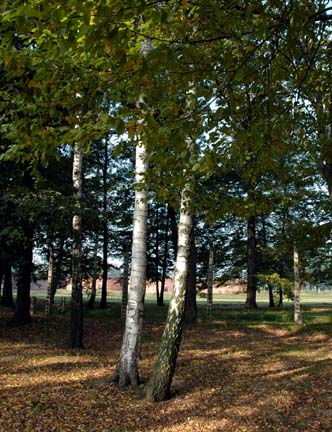 The Auschwitz II camp location was selected on March 1, 1941 when Reichsführer-SS Heinrich Himmler, the head of all the concentration camps, visited Auschwitz for the first time. He stood on the railroad overpass in Auschwitz and decided that the village of Birkenau, which he could see in the distance, would be an ideal place to expand the Auschwitz concentration camp because of its proximity to the railroad lines. The Polish name for the village was Brzezinka. Birkenau was opened on October 7, 1941 as a Prisoner of War camp for soldiers captured during the German invasion of the Soviet Union which had begun on June 22, 1941. Most of the Soviet POWs quickly died from starvation, disease and overwork; they were buried in mass graves on the northern side of the vast Birkenau camp. Out of over 13,000 Soviet POWs who were brought to Birkenau, only 92 were alive on January 17, 1945 when the last roll call was taken. The Germans did not feel the need to treat the Soviet soldiers in accordance with the Geneva Convention of 1929, because the Soviet Union had not signed the Convention and was not treating German POWs according to the laws of the Convention. The Birkenau camp is huge, covering 425 acres. The boundaries of Birkenau stretch a mile in one direction and a mile and a half in the other direction. When construction was completed, it had over 300 buildings with a capacity of 200,000 prisoners. The entire Birkenau camp was enclosed by an electrified barbed wire fence around the perimeter of the camp. The interior of the camp was divided into nine sections and each section was surrounded by another electrified barbed wire fence. Men and women were in separate sections, and the younger children stayed in the women's section. The photo below shows an interior barbed wire fence around the former men's camp, which is in section BIId to the left of the road shown in the picture. The Gypsy camp was in section BIIe, behind the men's camp on the west side. More information about the Gypsies can be found here. 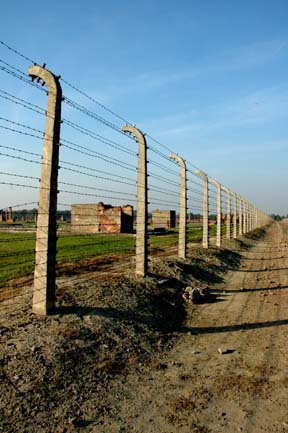 Visitors to Birkenau enter the former camp through the gate house on the east side and walk west down the main camp road toward the two largest gas chambers, Krema II and Krema III. The top of the map shown below points west and shows the western end of the Birkeanu camp where the Zentral Sauna is located. "The little white house" is shown behind the Sauna and to the right. The Sauna was the building where the clothing was disinfected in steam chambers; this building also had a large shower room. The buildings shown just below the Sauna on the map were the clothing warehouses. To the right of the clothing warehouses were Krema IV and Krema V (No. 17 on the map) which had gas chambers disguised as showers. Behind the clothing warehouses were the hospital barracks. On the left side of the map below (No. 15) are Crematorium II and Crematorium III, shown in red. The white part of these two buildings in the drawing denotes the undressing rooms and the gas chambers which were partially underground. No. 14 on the map denotes the main camp road with the women's camp on the left; the women's kitchen is right below Crematorium II. |
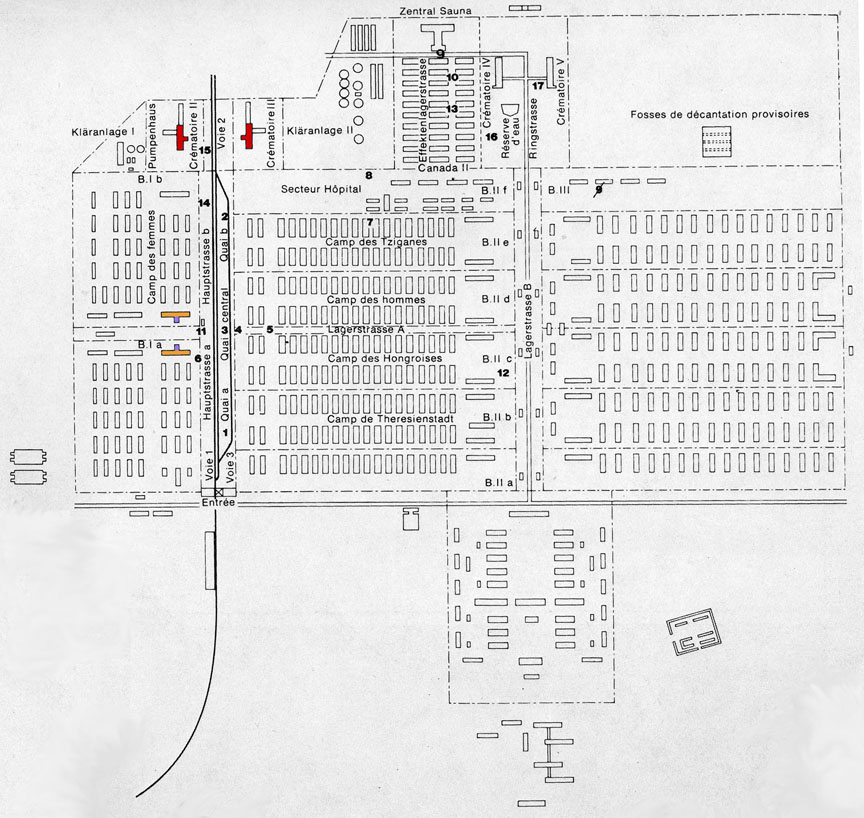
|
At the bottom of the map shown above, the train tracks can be seen going through an opening in the gate house on the left side of the drawing. Parallel to the tracks is the Hauptstrasse, or the main street of the camp. On the left side of the main street are the women's barracks with two disinfection chambers shown in orange in between the two sections of women's barracks. The photo below shows Hungarian Jews waiting in a Birch tree grove at the western end of the Birkenau camp on May 26, 1944. The Krema IV and Krema V gas chambers, disguised as shower rooms, are behind them, but out of camera range. These victims have been told that they are going to take a shower before being assigned to their barracks. They are standing across the road from the Sauna where there was a real shower room. The gassing of the Jews at Auschwitz-Birkenau was not a secret; all the prisoners eventually knew what was going on. The two largest gas chambers at Birkenau were inside barbed wire enclosures, on either side of the main camp road, within plain sight of the prisoners. The two smaller gas chambers were across the road from the Sauna building where incoming prisoners had to take a shower. In the movie Schindler's List, the women coming out of the shower building can see the smoke coming out of the tall chimney of Krema IV. Newcomers who inquired about their loved ones, who were missing, were told that they had gone "through the chimney." Elizabeth Mann, a survivor of Birkenau, said in a speech at the Simon Wiesenthal Center that when the Hungarian Jews were brought to Birkenau, beginning in late April 1944, the camp became so over-crowded that the prisoners were sleeping five to a bed and five prisoners were sharing one coffee cup. Mann said that the prisoners at Birkenau never knew whether water or gas was going to come out of the showerheads in the Sauna, where the women prisoners took showers; she also told an audience at the Simon Wiesenthal Center that the Nazis made soap out of the fat of dead Jews. Auschwitz-Birkenau did not start out as a death factory; it evolved over time. According to Holocaust historian Raul Hilberg: What began in 1941 was a process of destruction not planned in advance, not organized centrally by any agency. There was no blueprint and there was no budget for destructive measures. [These measures] were taken step by step, one step at a time. Thus came about not so much a plan being carried out, but an incredible meeting of minds, a consensus -- mind reading by a far-flung bureaucracy. Regarding Hitler's decision to exterminate the Jews, Holocaust historian Raul Hilberg told the French newspaper Le Monde des Livres the following on October 20, 2006: There was no pre-established guiding
plan. As for the question of the decision, it is in part The gassing of the Jews began on a small scale at the main camp in 1941, and it was not until the Summer of 1943 that four gas chambers at Birkenau were in full operation. In one year, in 1942, there were 2.7 million Jews murdered by the Nazis, but only 200,000 out of this number were gassed at Auschwitz-Birkenau. The gassing operation at Birkenau in 1942 was nothing more than two make-shift gas chambers in a couple of old farm houses. There were no crematory ovens at Birkenau in 1942, and at the Auschwitz main camp, there were only three ovens, which could burn 340 bodies in a 24-hour period. The bodies of the Jews who were gassed at Birkenau in 1942 were buried in mass graves near the little red house. The bodies were later dug up and burned on pyres, so as not to contaminate the ground water at Birkenau. The bodies of thousands of prisoners who had died in the typhus epidemic, that was out of control by July 3, 1942, also had to be exhumed and burned. Commandant Hoess wrote in his autobiography that "The number of corpses in the mass graves amounted to 107,000." Otto Moll, the SS man who was in charge
of digging the mass graves at Birkenau in 1942, disputed Hoess'
version of the story; on April 16, 1946, Moll told an interrogator
at Nuremberg: In 1943, the construction of four new brick buildings, called Krema II, Krema III, Krema IV and Krema V, was completed. The four new buildings all contained ovens for cremating the bodies, and homicidal gas chambers where the Jews were gassed with Zyklon-B. The numbering of the crematory buildings took into consideration that the first crematorium, in the main camp, was now called Krema I. There was a total of 500,000 Jews killed in all the Nazi concentration camps in 1943, and half of these deaths occurred in Auschwitz-Birkenau. The source for this information is a book entitled "Auschwitz, A New History," written by Laurence Rees, and published in 2005. The photo below shows elderly and disabled Jews, who have just arrived inside the Birkenau camp on a train and are waiting to be transported by trucks to the gas chamber.  The photo above shows the original brick barracks in the former women's camp in 2005. This camp was first occupied by Soviet POWs. The first Birkenau prisoners had to tear down the brick houses in the Polish village of Brzezinka, which the Germans called Birkenau, and use the bricks to construct primitive barracks, built on the ground without foundations. Eventually, the houses in 6 more Polish villages were torn down in order to expand the Birkenau camp. Birkenau was built on marshy ground which had to be drained. The ground at Birkenau is so wet that there are spots at the western end that look like a bog garden with plants that grow only in wet places. The photo below shows prisoners digging a drainage ditch at the western end of the camp. This was part of Heinrich Himmler's ambitious plan to set up a huge farm at Auschwitz. 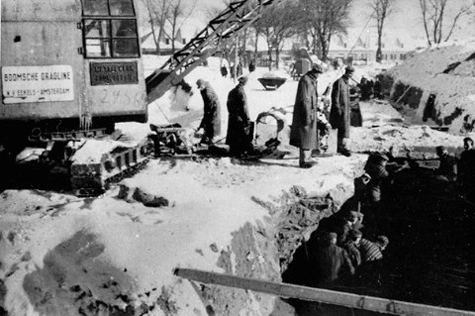 According to the book entitled "Auschwitz, 1270 to the present" by Deborah Dwork and Robert Jan van Pelt, Heinrich Himmler got the idea of using the Auschwitz concentration camp to establish a large agricultural estate as early as November 1940 after Auschwitz Commandant Rudolf Hoess paid him a visit. "The two men began to plan the transformation of Auschwitz into an agricultural experiment station which would service the entire region." At that early date, the projected inmate population of Auschwitz was 10,000 and Himmler envisioned that most of them would work on the experimental farm, according to Dwork and van Pelt. "It was the metamorphosis of the camp into an agricultural estate worked by slaves that caught [Himmler's] fancy; it fit his fantasy of the German east, and he was enraptured by the vision of Auschwitz playing a central role in the reclamation of that area." The town of Auschwitz had originally been built by Germans and German farmers had formerly owned the land in the area, which Himmler wanted to reclaim for the Greater German Reich. According to the book by Dwork and Van Pelt, most of the slave labor on the Auschwitz experimental farm was done by women. The following quote is from "Auschwitz, 1270 to the present": His [Himmler's] bucolic fantasy engendered a brutality that exceeded the conditions in the sand and gravel pit industrial work assigned to men. The women simply had no machinery of any kind to help them. It was lethal work. Many died, and nearly no one survived without permanent injury. It was too great an assault for anyone to sustain, and it is possible that one day early in October 1942, women slave laborers at the agricultural farm in the Auschwitz subcamp of Budy tried to break out. German women kapos killed the approximately ninety French Jews with poles and axes, claiming to suppress an uprising. Not one of the prisoners survived that day. According to a book entitled "Auschwitz," which I purchased in 1998 from the museum at Auschwitz I: "Increasing the capacity of Auschwitz to supply slave labour was of prime importance to the Nazis; from the moment the camp was established, prisoners were employed in expanding it." When the camp was abandoned in January 1945, another section that would provide housing for 50,000 more prisoners was partially completed. The new section, called Mexico, is shown on the right side of the large map on this page. Birkenau was by far the largest camp in the Nazi concentration camp system, and the overwhelming majority of the prisoners were Jews who did not work. There were no factories at Birkenau; the whole camp was intended to be a death factory for gassing the Jews. 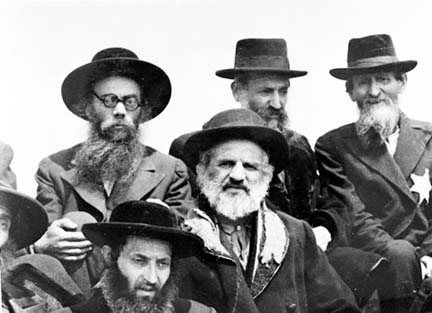 According to a German document dated 28 June 1943, issued by the Central Management of the Building section of the Waffen SS and Police, the four new crematoria at Birkenau had a combined capacity of 4,416 corpses in a 24-hour period. When problems with the ovens in Krema IV and Krema V developed, bodies were burned in pits on the north side of Krema V, as shown in secret photos taken in the camp. When the former Commandant, Rudolf Hoess, returned to Birkenau in May 1944, the first thing he did was to order the construction of a railroad line that went through the Birkenau gate and continued on into the camp, right up to the gas chambers in Krema II and Krema III at the western end of the main camp road. Between September 1943 and May 1944, thousands of Jewish prisoners were sent from the Theresienstadt Ghetto to the Birkenau camp. Theresienstadt was the so-called "Paradise Ghetto" in what is now the Czech Republic; this was where the Nazis allowed a Red Cross inspection after first cleaning up the camp to impress the delegates. The Czech prisoners from Theresienstadt were housed inside Birkenau in a special "Family Camp," surrounded by electrified barbed wire, where men, women and children were allowed to live in separate barracks, but inside the same enclosure. In two successive actions, according to information given by the Auschwitz Museum, the Jews in the Family Camp were gassed on March 3, 1944 and again on July 11 and 12, 1944. According to Ruth Elias, a prisoner in the family camp who wrote a book entitled "Triumph of Hope," the prisoners in the Family Camp were instructed to send letters and postcards to friends and family members before they were gassed in the first action on March 3, 1944. These prisoners had arrived at Birkenau six months before they were killed. According to Danuta Czech, the decision to close the Family Camp was made on July 2, 1944. Dr. Josef Mengele selected 3,080 of the Jews in the Family Camp to be sent to work in various camps in Germany and the rest were sent to the gas chamber. As for the reason for gassing the Czechs in the Family Camp, Dr. Miklos Nyiszli, a Hungarian Jew who arrived at Birkenau on May 29, 1943, wrote: In the Czech Camp both the children and aged had been greatly weakened by their two-year ordeal: the children's bodies were mere skin and bones, and the elderly prisoners were so weak they could scarcely walk. Both had to relinquish their places to new arrivals who were still strong enough to work. It was not until May 1944 that the Birkenau camp became a killing factory on a mass scale with trains bringing 437,402 Jews from Hungary to Auschwitz between April 29, 1944 and July 9, 1944. Many of them were sent directly to the gas chambers without going through a selection process to save those who were capable of working in the factories. Gassing of the Gypsies at BirkenauZyklon-B used for gassing at BirkenauSelection for the gas chamber or laborAuschwitz III - aka MonowitzMonowitz gas chamber?Liberation of Auschwitz-BirkenauSurvivors of Birkenau campDeath StatisticsHistory of AuschwitzBack to Auschwitz-Birkenau indexHomeThis page was last updated on November 7, 2009 |